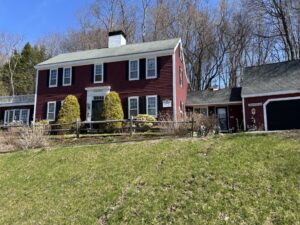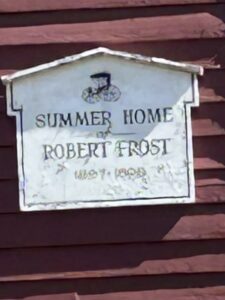Robert Frost in Amesbury, Mass. (1897-1898). Who Knew?
Robert Frost in Amesbury, Mass. (1897-1898). Who Knew?
Well, somebody knew about this but I didn’t even though I’ve been in Amesbury for eight years. Plus, I’ve studied authors of the region since reading Thoreau’s “A Week on the Concord and Merrimack Rivers” in the 1970s. How did I miss Robert Frost living a couple of miles away from my current home? It’s no exaggeration to say Walt Whitman, Emily Dickinson, and Robert Frost remain the top three figures in American poetry, at least for name recognition—two of them from our state.
A month ago on the Amesbury Facebook chat group someone mentioned that Frost had spent two summers in the community when he was a young man with wife Elinor and their new baby, Elliott. Helped by a biography of the poet by Lawrence Thompson, early letters from Harvard University Press, and the Library of America volume of Frost’s poems with hyper-detailed chronology, as well as various sources on the internet, I pieced together the facts.
The crowning assist came from the Amesbury Public Library, where the reference librarian Jodie Blouin went to the Massachusetts Cultural Resource Information System online for a profile of the clapboard house with garage which remains occupied and looked busy on the day my wife Rosemary and I visited. On the front of the house is a large plaque that reads Summer Home of Robert Frost, 1897-1898. It wasn’t hard to find when we knew where to look. Having driven by hundreds of times since we moved to Amesbury, we had not noticed the white sign.
The Frost family rented the 1775 house at 5 Evans Place just on the other side of the Merrimack River road not far from the notable Lowell Boat Shop. The J. Guest-John Blaisdell House is a two-story structure, now painted red, in the Georgian architectural style. Blaisdell made hats, which was a big industry in Amesbury. The house stands on a rise just where narrow Crum Hill Road veers off the main street. The area was also known as both Salisbury Point and Webster’s Point, built up when this stretch of the Merrimack River was dominated by shipbuilding.
Frost was twenty-three when he and Elinor rented the house. How did they know it was available? And how did they afford the rent? There’s no mention that another family shared the large house during the two summers. Maybe it was common for city people in Lawrence to take a break in the summer to cool off along the river. His family had been living with his mother, Isabelle, in Lawrence. More research needed on this. What did the family do in those two summers? The Thompson biography is not much help. There’s an anecdote about Frost going fishing in the river with a neighbor. Unfortunately, no letters from Amesbury survived, so we don’t have much context for time spent there.
Frost had various jobs in this period including newspaper reporting and teaching in his mother’s school in Lawrence. After a short stay at Dartmouth College a few years before, while in Amesbury Frost sought to enroll at Harvard University and was accepted—but left after his second year.
With a growing family and pressed to earn a living, Frost moved the family upriver to Methuen, a house with a barn. Backed by his grandfather, Frost tried his hand as a chicken farmer, a poultryman, and had some success. He also wrote articles for farm magazines, all the while still composing poems at the kitchen table at night. His next move was a more serious attempt at working the land when his grandfather bought for his family a small farm in Derry, N.H., the site of today’s Frost Farm run by the State of New Hampshire as a tourist site.
Justifiably, our picture of Frost in the Merrimack Valley is dominated by his time in Lawrence where he grew up and graduated from high school. The bits of information we have about his time in Methuen and Amesbury, as well as in Salem, N.H., just north of Lawrence, make his regional footprint a bit wider and deeper.
There’s another Amesbury link, this one in Frost’s poetry. In his 1936 collection “A Further Range” he has the poem “A Blue Ribbon at Amesbury,” which up to now I assumed was set in Amesbury, N.H., since he had left the Merrimack Valley by that time. There is no Amesbury, N.H., so it is not unreasonable to think the poem is a reflection on a prize hen from his chicken-raising days in Methuen and Derry. Perhaps a local agricultural fair. I’ll have to dig into this subject.
For more on Frost’s life check the Wikipedia page with all the basic facts.


Thank you for the article. Perhaps Frost’s time in Amesbury had a tangible positive impact on the development of his poetry.
Fascinating! Yes, given there is an Andover, NH, I too would have guessed the poem was reflecting of an Amesbury NH. You and Rosemary have a book in your collective minds, I do think, of little known places of famous New England writers. Side-by-side with their poem or selection of prose. And photos! Found this: https://amesburycarriagemuseum.org/news/2018/10/19/amesburys-own-agricultural-fair
Susan April, many thanks for the demon research that led to the Amesbury Carriage Museum’s own discovery about massive agricultural fairs in town around the turn of the century. This may be the missing link to explain the origin of Frost’s poem “A Blue Ribbon at Amesbury.” There’s a chance, maybe a good chance, that Frost wrote about one of his own award-winning hens that he had entered in a competition in Amesbury around the time he was raising chickens in Methuen Mass. and Derry N.H. The time frame fits. I don’t think anyone else has connected these dots. Maybe somewhere in the old newspaper archives there’s a one-line mention about a hen owned by R. Frost winning a blue ribbon. There you go. Making history. Possibly. But an encouraging start, Susan.
You write: “The bits of information we have about his time in Methuen and Amesbury, as well as in Salem, N.H., just north of Lawrence, make his regional footprint a bit wider and deeper” — as does your archival digging and sharing of this intriguing morsel. Thank you, Paul.